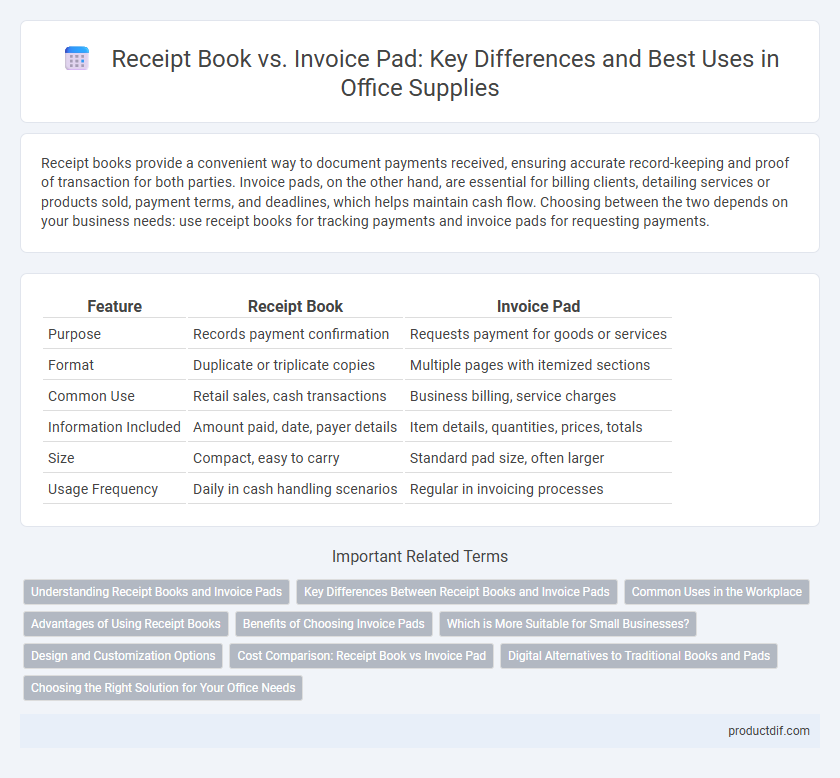Receipt books provide a convenient way to document payments received, ensuring accurate record-keeping and proof of transaction for both parties. Invoice pads, on the other hand, are essential for billing clients, detailing services or products sold, payment terms, and deadlines, which helps maintain cash flow. Choosing between the two depends on your business needs: use receipt books for tracking payments and invoice pads for requesting payments.
Table of Comparison
| Feature | Receipt Book | Invoice Pad |
|---|---|---|
| Purpose | Records payment confirmation | Requests payment for goods or services |
| Format | Duplicate or triplicate copies | Multiple pages with itemized sections |
| Common Use | Retail sales, cash transactions | Business billing, service charges |
| Information Included | Amount paid, date, payer details | Item details, quantities, prices, totals |
| Size | Compact, easy to carry | Standard pad size, often larger |
| Usage Frequency | Daily in cash handling scenarios | Regular in invoicing processes |
Understanding Receipt Books and Invoice Pads
Receipt books provide a reliable method for recording payments received, offering sequential numbering and carbon copies for accurate transaction tracking. Invoice pads facilitate billing by detailing items or services sold, payment terms, and due dates, helping businesses maintain organized accounts receivable. Choosing between receipt books and invoice pads depends on whether the focus is on confirming payment or requesting payment from customers.
Key Differences Between Receipt Books and Invoice Pads
Receipt books primarily serve to confirm payment received, featuring pre-printed, sequentially numbered pages for recording transaction details such as date, amount, and payer information. Invoice pads, conversely, are designed for billing purposes, allowing detailed itemization of products or services provided, payment terms, and due dates. Key differences include their function--receipt books document completed transactions while invoice pads request payment--and their format, with receipts being simpler and invoices containing comprehensive billing information.
Common Uses in the Workplace
Receipt books are commonly used in workplaces to provide customers with proof of payment and transaction details, facilitating record-keeping for both parties. Invoice pads primarily serve businesses by itemizing sales and services rendered, streamlining billing processes and ensuring accurate financial tracking. Both tools enhance organizational efficiency but cater to distinct accounting and customer interaction needs.
Advantages of Using Receipt Books
Receipt books offer a reliable way to provide customers with immediate proof of payment, enhancing trust and record accuracy in office transactions. Their pre-numbered pages simplify tracking and auditing, reducing errors compared to handwritten invoices. Unlike invoice pads, receipt books require no electronic device, ensuring accessibility and efficiency in any office environment.
Benefits of Choosing Invoice Pads
Invoice pads streamline billing processes by offering pre-formatted, professional templates that enhance record-keeping accuracy and reduce errors. Their carbonless copy feature ensures instant duplicates for both the seller and buyer, improving transaction transparency and accountability. Designed for customization, invoice pads accommodate detailed itemization, making them ideal for businesses aiming to maintain clear, consistent financial documentation.
Which is More Suitable for Small Businesses?
Receipt books are ideal for small businesses that require a simple, immediate proof of transaction, as they are cost-effective and easy to use without the need for complex accounting systems. Invoice pads offer more detailed documentation for payment terms and itemized billing, making them suitable for small businesses that manage ongoing client relationships or need to track payments accurately. Choosing between the two depends on whether the business prioritizes quick receipt issuance or detailed invoicing for cash flow management and record-keeping.
Design and Customization Options
Receipt books typically feature carbonless paper with pre-printed sequential numbering for efficient transaction recording, allowing limited customization mainly in logo placement and color schemes. Invoice pads offer more extensive design flexibility, including multiple invoice templates, detailed itemization sections, and personalized branding elements such as custom fonts, company information, and promotional messages. Both options support tailored layouts, but invoice pads provide enhanced customization suited for complex billing requirements and professional presentation.
Cost Comparison: Receipt Book vs Invoice Pad
Receipt books typically cost less than invoice pads due to simpler design and fewer pages, making them ideal for small businesses with basic transaction needs. Invoice pads often have higher production costs because they include detailed fields for itemization, taxes, and terms, which justify their premium price for businesses requiring professional billing documentation. Choosing between the two depends on budget constraints and the necessity for detailed invoicing features in office supply expenditures.
Digital Alternatives to Traditional Books and Pads
Digital alternatives to traditional receipt books and invoice pads offer enhanced efficiency, accuracy, and eco-friendliness for office supply management. Mobile apps and cloud-based software enable instant creation, storage, and sharing of receipts and invoices, reducing paper waste and minimizing manual errors. Integration with accounting systems streamlines financial tracking and reporting, making digital solutions a preferred choice for modern businesses.
Choosing the Right Solution for Your Office Needs
Receipt books provide a straightforward method for documenting sales transactions with pre-numbered pages that ensure accurate record-keeping, making them ideal for businesses requiring quick proof of payment. Invoice pads offer customizable templates that help track billing details, payment terms, and itemized charges, supporting efficient financial management and client communication. Selecting the right solution depends on your office's transaction volume, documentation needs, and whether receipts or detailed invoices better align with your accounting practices.
Receipt Book vs Invoice Pad Infographic

 productdif.com
productdif.com